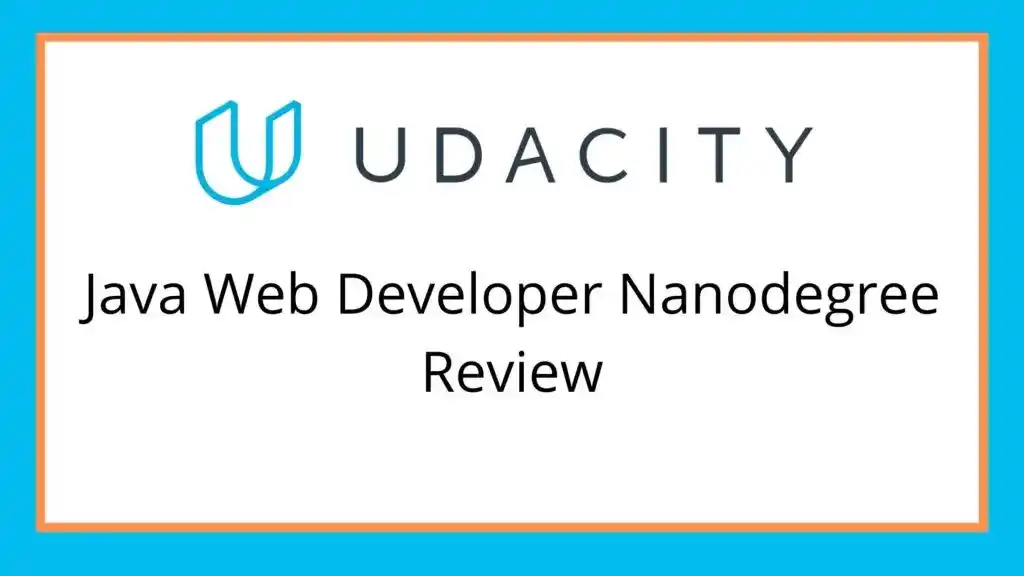Are you planning to enroll in Udacity Java Web Developer Nanodegree?… If yes, read this Udacity Java Web Developer Nanodegree Review and then decide whether to enroll in the program or not.
Now, without further ado, let’s start the Udacity Java Web Developer Nanodegree Review.
Udacity Java Web Developer Nanodegree Review
- Udacity Java Web Developer Nanodegree Price and Duration
- How to Get Udacity Java Web Developer Nanodegree at Low Cost?
- Who Should Enroll in Udacity Java Web Developer Nanodegree?
- Udacity Java Web Developer Nanodegree Syllabus and Projects
- Instructors of Udacity Java Web Developer Nanodegree
- Is Udacity Java Web Developer Nanodegree Worth It?
- Conclusion
I consider any course or program worth it on some parameters. So, in this Udacity Java Web Developer Nanodegree Review, I will review the Nanodegree program on some parameters. And based on these parameters, I will tell you whether this Udacity Java Web Developer Nanodegree is worth it for you or not.
So, the first parameter is Price.
Let’s see whether Udacity Java Web Developer Nanodegree is worth the money or not.
Udacity Java Web Developer Nanodegree Price and Duration
According to Udacity, the Udacity Java Web Developer Nanodegree program will take 4 months to complete if you spend 10 hours per week. And for 4 months they cost around $1199. But Udacity offers two options: either pay the complete amount upfront or pay monthly installments of $399/month.
I know Udacity Java Web Developer Nanodegree is expensive as compared to other MOOCs.
I believe that Udacity Java Web Developer Nanodegree is not worth it if you pay the full money. Because there are various courses available at low cost, but, If you get the Udacity Java Web Developer Nanodegree at low cost by saving a few bucks, then you can enroll in Udacity Java Web Developer Nanodegree.
Do you want to know what are these tricks to get Udacity Java Web Developer Nanodegree at a low cost?
So, let’s see the three methods which you can use to get Udacity Java Web Developer Nanodegree at a low cost.
How to Get Udacity Java Web Developer Nanodegree at Low Cost?
These 3 methods are-
- Get Some Discounts
- Complete the whole Nanodegree in less time.
- Apply for Udacity Scholarship
1. Get Some Discounts
Most of the time, Udacity offers some discounts. When they offer a discount, it appears something like that-
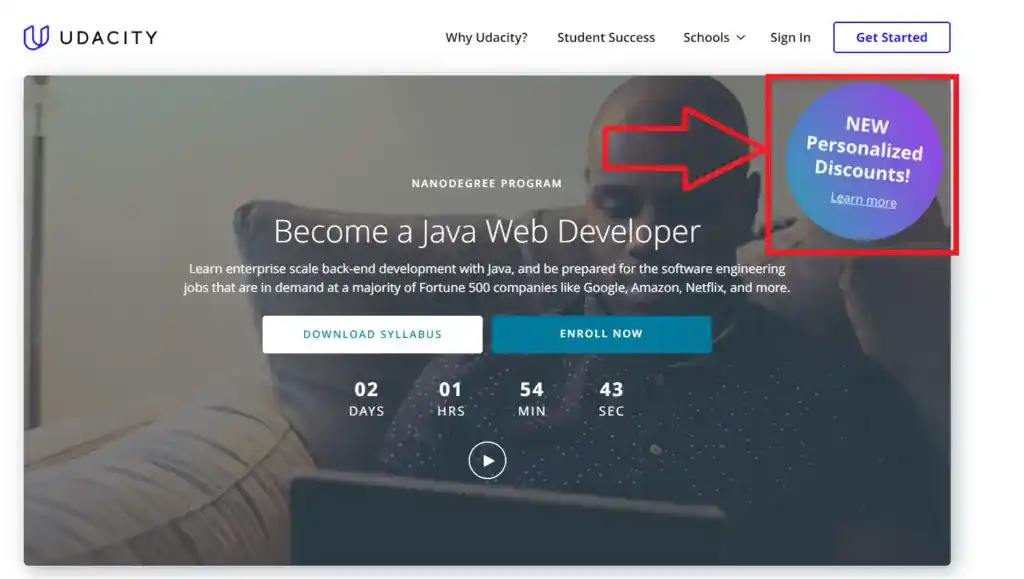
When you click on the “New Personalized Discount”, you will be asked to answer 2 questions.
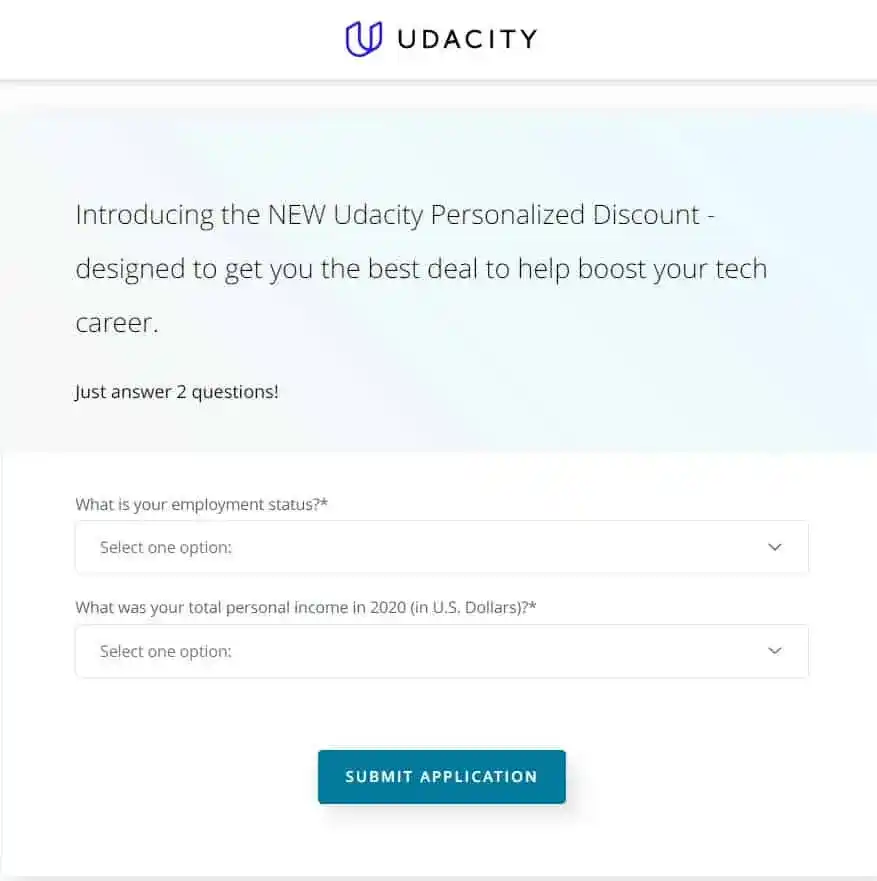
After answering these two questions, press the “Submit Application” button. And then you will get a discount with a unique Coupon Code. Simply copy this code and paste it at the time of payment.
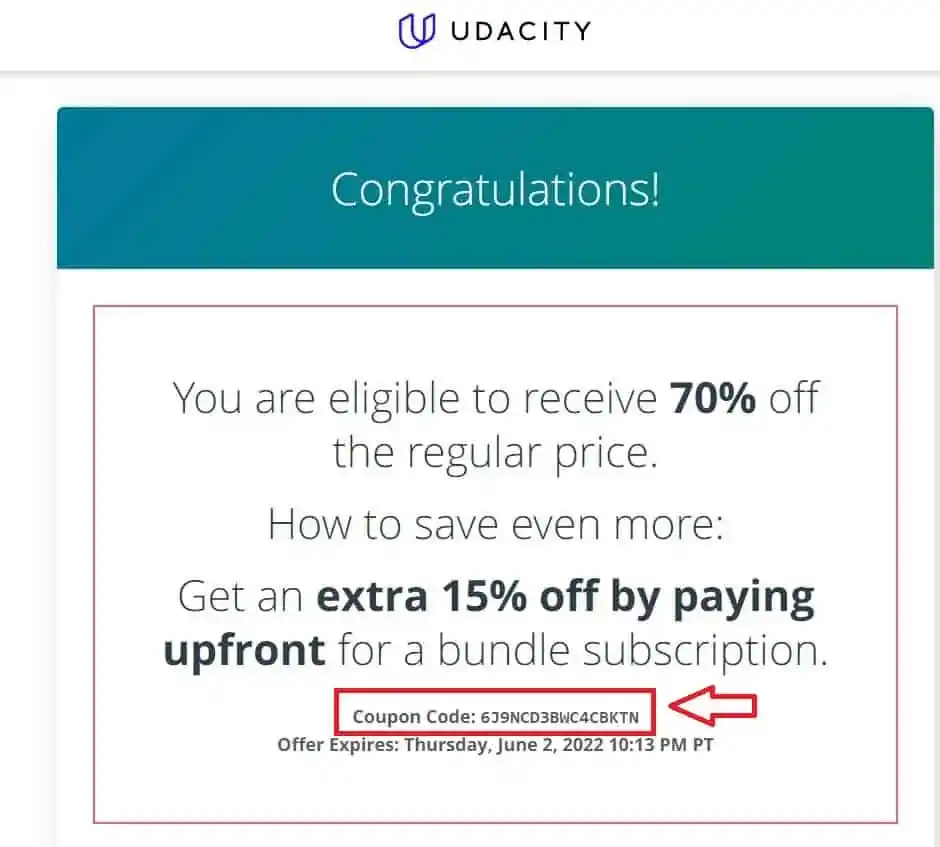
You need to apply the coupon provided by Udacity at the time of checkout. And you will get a discount on the Udacity Java Web Developer Nanodegree program. So to get a discount on Udacity, you need to wait for their sale.
You can check the current Discount of Udacity Java Web Developer Nanodegree> Here.
2. Complete the whole Nanodegree in less time
To complete the Udacity Java Web Developer Nanodegree program in less time, you need to manage your time productively.
You need to plan your day before and create a to-do list for each day. And you need to spend a good amount of time daily on the program.
According to Udacity, you need to spend 10 hours per week to complete the whole program in 4 months.
Right…?
That means, daily you need to spend 1.5 hours, but if you double the time and give daily 3 hours, then you can complete the whole Nanodegree program in 2 months.
For managing your time and avoiding any distractions, you can use the Pomodoro technique to increase your learning.
And you can also implement the project phases after watching the related lecture. By doing this way, you can save your time by watching one video two times. One at the time of learning and the second at the time of working on the project.
I hope these tips will help you to complete the Udacity Java Web Developer Nanodegree in less time. And you can save two months’ fees.
3. Apply for Udacity Scholarship
To apply for Udacity Scholarship, you need to go on their Scholarship page, which looks like something like that-
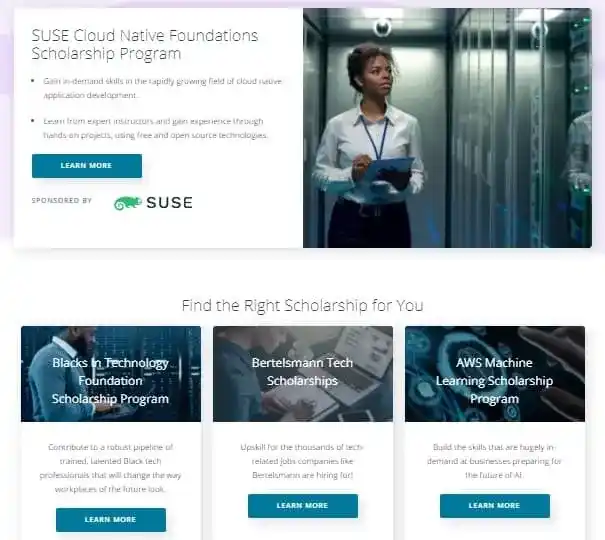
On this page, you have to find the scholarship for the program you want to enroll in. If you found your Nanodegree program on the list, then you need to apply for the scholarship by filling out these details-
- Background Information
- Prerequisite Knowledge
- Your Goals
- Additional Questions
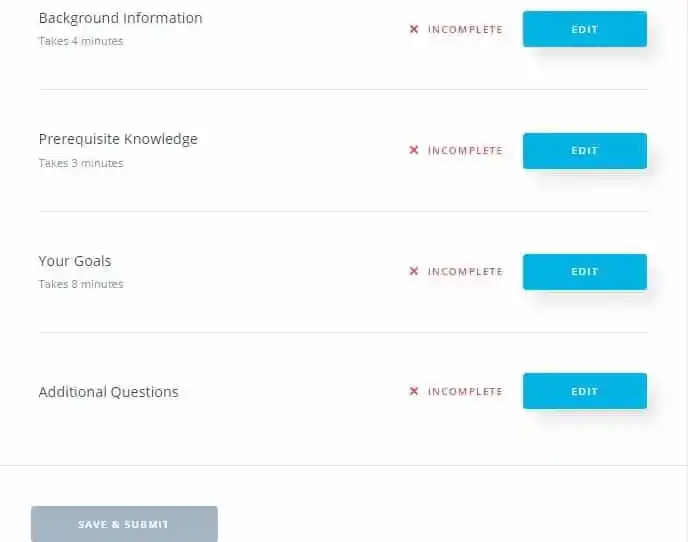
In the background information section, they will ask about your Country, Age, Gender, ethnicity, the highest level of education, current job role, years of professional experience, and how many hours can you dedicate to the program per week?
The prerequisite Knowledge section varies depending on the Nanodegree program you are applying for.
In the Goals section, you have to tell your primary purpose in participating in this scholarship program, what you hope to accomplish through this program?, and Why should you receive a scholarship?
In the last section which is Additional Questions, you have to agree to their terms and conditions.
You should fill the Goals section very carefully so that you increase your chance of getting a scholarship.
After filling out these details, you need to click on the “Save and Submit“ button. And by doing so, you have applied for Udacity Scholarship. And if you are selected, then you will be notified via email.
But if your program is not listed in the scholarship section, then you fill out this form on the Scholarship page section-
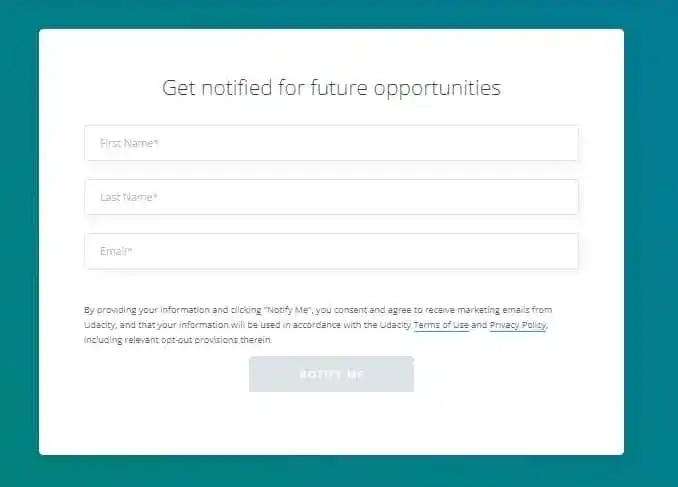
So, whenever the scholarship will available, you will be notified. I hope now you understood the procedure.
If you follow any of these three methods, you can save a few bucks.
If you get Udacity Java Web Developer Nanodegree at a low cost by following these methods, then I would say it is worth it.
The next Parameter is whether you have the required knowledge for this Udacity Java Web Developer Nanodegree or not. I mean the prerequisites for the Nanodegree Program.
Because without having prerequisite knowledge, you will feel lost in the Udacity Java Web Developer Nanodegree program. And you may think that you have wasted your money with the wrong program. That’s why this is the important parameter I always consider before selecting any course.
Who Should Enroll in Udacity Java Web Developer Nanodegree?
If you have previous knowledge of Java Programming, then only you should enroll in this Udacity Java Web Developer Nanodegree.
Along with that, you should know how to initialize and use primitive Java data types (i.e. float, int, etc), and how to select and use Collections from java.util.Collections, how to design and create classes, interfaces, subclasses and class methods in Java, how to launch Java applications from an IDE, and how to write basic queries in SQL.
If you are a beginner with no previous Java Programming experience, I would not suggest this Udacity Java Web Developer Nanodegree. In this case, first, learn Java Programming from any YouTube videos or online courses.
So, based on my experience, Udacity Java Web Developer Nanodegree Program is not worth it for Beginners with no Java Programming knowledge.
My next parameter is the Quality of the Content and the Projects Covered. So, let’s see the content and projects covered in the Udacity Java Web Developer Nanodegree.
Udacity Java Web Developer Nanodegree Syllabus and Projects
If you want to learn Java Programming for web development, then practical exposure is essential. Right?
So, if any course covers only theory, I believe this is the waste of time. Udacity Java Web Developer Nanodegree focuses on the practical side.
After every set of courses, there is a project that you need to submit. Due to its practical approach, you will get to learn various new things. Because when you implement it by yourself, your understanding becomes stronger. And Programming is all about implementation.
In Udacity Java Web Developer Nanodegree, there are 4 courses and 4 projects. These are the 4 courses and each course has one project that you need to submit before moving to the next course.
Now, let’s see what topics each course will cover.
Course 1- Spring Boot Basics
In this course, you will learn the basics of web development in Java such as how the Java Application Server facilitates web development, how to identify the role of a Servlet within a Java Application Server, and the role of Spring as a Servlet application tool, and how to add and update project dependencies within a Maven POMfile.
After that, you will learn the basics of Spring Boot for web development. And learn how to set up and configure a working Spring Boot Environment for web development, how to identify Spring registered components in Java applications based on Spring annotations, and how to annotate code to register custom components with a Spring App.
Then you will learn Spring MVC and Thymeleaf and learn how to design HTML templates with Thymeleaf and populates HTML
templates with Spring’s MVC data model, how to write variable resolution expressions within a ThymeLeaf template to access model data.
In the last two lessons of this course, you will learn Data Persistence and Security, and Testing.
You will learn how to identify mappings between Java objects and SQL tables and leverage those mappings to connect an application with a data store, how to write MYBatis SQL template queries using an application’s data model, and how to use Spring Security to automatically filter web traffic based on that information.
And at the end of this course, you will learn how to use Selenium/Webdriver to automatically perform user actions in order to test the functionality of web pages, how to use the JUnit assertion class to test specific success or failure points, how to organize tests into Page objects so that the application structure is mirrored by the test structure.
After completing this course, there will be one project, which you need to submit.
Project 1- Build a Web-based Personal Storage Application
In this project, you have to use the skills acquired in the first course to build a web-based personal storage application: SuperDuperDrive!
For this project, you have to implement user-facing features like file, note, and secure credential storage with industry-standard, full-stack development tools.
You have to use Spring MVC and Thymeleaf to build a Java-backed web app. Then you have to store user data with MyBatis, a dead-simple ORM library and secure that data from unauthorized access with Spring Security.
And at the end, to verify that the app is feature-complete, you have to implement a series of automated user tests with JUnit and Selenium.
When you complete this project, the reviewer will review your code and give feedback. The feedback and the peer community will help you throughout the program to clear your doubts.
After submitting this project, you can move forward toward the second course.
Course 2- Web Services and APIs
In this course, you will learn about Web Services and APIs.
First, you will learn about web services and their advantages, how web services communicate, and the differences between web services, APIs, and microservices.
After that, you will learn the REST architectural style and the importance of data formats, how to develop a REST API using Spring Boot, and incorporate exception handling, and how to use proper HTTP response codes.
Then you will learn how to develop GraphQL APIs with Spring Boot and how to use GraphQL to execute queries and operations on data.
After that, this course will cover Microservices Architecture (MSA), a microservice using Spring Boot, and how to register a microservice.
In this course, you will also learn how to secure API Endpoints with Spring Security, how to consume Web Services and APIs, how to document REST APIs, and how to test REST APIs.
After completing this course, there is another project which you have to submit.
Project 2- Build the Backend System for a Car Website
In this project, you have to build a backend system for a website of cars.
This backend will be composed of vehicles list services, pricing services, and location services as mentioned below:
- Vehicles API
- A REST API to maintain vehicles data (CRUD)
- Pricing Service
- A REST API to retrieve the price of a vehicle
- Location API
- An HTTP client to retrieve the location of the vehicle
For this project, you have to use Java APIs and frameworks to integrate different services using different communication styles. And you have to write the CRUD operations to store and retrieve vehicle data and implement an HTTP client to retrieve the address of the vehicle given the latitude and longitude.
You also have to integrate the clients (Vehicle API) with pricing services to retrieve the price. And at the end, you have to learn how to use Swagger to efficiently create documentation for their APIs.
Throughout this project, you will be guided to write unit tests, error handling, logging, and other best practices.
Course 3- Data Stores & Persistence
In this course, you will learn how to build applications that read and write relational databases using both the Java Persistence API (JPA) and SQL.
First, you will learn how to design Entities that map Java data types to database structures, how to represent complex associations between Entities in persistence, how to identify and select inheritance strategies, and how to isolate Entity scope through the use of annotations and DTOs.
After that, you will understand and utilize key concepts in Object Relational Mapping (ORM) such as Persistence Context and Entity Manager, and learn about the Repository design pattern and learn how to build implementations for your Repository methods automatically with Spring Data JPA.
Then you will learn how to connect Spring Boot to both internal and external data sources, how to customize Spring DataSource construction and injection, and how to configure unit tests to use different data sources.
In the last, you will learn about the differences in Data Object design when retrieving data with SQL, how to initialize Data Sources with SQL scripts, how to use the Data Access Object design pattern, how to execute SQL queries with JdbcTemplate and automatically map the results to your Data Objects, and how to decide when to use SQL and when to use Hibernate, and learn how to combine them both in the same project.
At the end of this course, you have to work on a project to test your understanding.
Project 3- Design the Data Model for a SaaS Application
In this project, you have to design and implement the data model for Critter Chronologer, a Software as a Service application that provides a scheduling interface for small businesses that take care of animals.
The goal of this project is to allow users to create schedules that associate pets, owners, and employees with calendar events.
For this project, you have to configure your application to connect to an external database and use both JDBC and Hibernate to persist changes to it.
Basic CRUD operations will be exposed via a REST controller layer so that you can test your application using Postman.
The mentor will not only tell you your mistakes but also suggest where to improve by showing the improved code.
The last and next course is-
Course 4- Security and DevOps
In the last of this Udacity Java Web Developer Nanodegree, you will learn the basics of git such as branching, pull requests, and merging.
Then you will learn the best practices for authorization and authentication. And learn how to identify the need for security in modern-day web applications, and how to implement modern authorization and authentication technologies such as password hashing and JWT.
After that, you will learn how to identify important application metrics and log them, how to send logs to Splunk, and how to create visualizations and dashboards in Splunk to display those metrics.
At the end of this course, you will learn Jenkins and CI/CD. And learn how to create a build pipeline using Jenkins, how to build a Docker Image, how to create a CI pipeline for a Docker Image, and how to deploy a Docker container in production.
When you complete this course, there will be the last project of this Udacity Java Web Developer Nanodegree.
Project 4- Implement Authorization for an eCommerce Application
In this project, you have to add authorization using Spring Security with OAuth and username/password combinations to an eCommerce web application created in Spring Boot.
For this project, proper security and hashing will need to be implemented to store this data as well.
You have to identify the right metrics for an effective analytics environment and use either Splunk or ELK to analyze the metrics.
You also have to automate the configuration and deployment of these systems and the application. And use Jenkins to integrate with your version control and deploy your application to AWS.
So, there are the 4 Courses and 4 Projects for Udacity Java Web Developer Nanodegree. The best thing which I like about Udacity Java Web Developer Nanodegree is that they focus on the Practical Aspects. Because web development is all about practice.
The mentor will read all your codes piece by piece, not only the result. This is the unique feature of Udacity.
The overall quality of the course and projects is worth it. If you consider this parameter, I would suggest the Udacity Java Web Developer Nanodegree.
The next parameter of this Udacity Java Web Developer Nanodegree Review is the Instructors of the course. This is an important parameter, you should not avoid this parameter. Because, if the instructors are not experienced, then how they can teach the concepts.
So, let’s see how are the instructors of the Udacity Java Web Developer Nanodegree.
Instructors of Udacity Java Web Developer Nanodegree
- Kesha Williams– Kesha has over 20 years of experience in software development and is a software engineering manager at Chick-fil-A, routinely leading innovation teams in proving the use of cloud services to solve complex business problems. She was recently named an Alexa Champion by Amazon.
- Sareeta Panda– Sareeta is a Java enthusiast and Senior Developer at Walmart e-Commerce. She specializes in Enterprise Application Development with Java and Kafka, NoSQL, Spring security, and CI/CD. Sareeta has over a decade of experience, spanning recently acquired startups to top Fortune 500 companies.
- Peter Zastoupil– Peter Zastoupil is an enterprise developer and technical administrator. He has seven years of on-the-job experience building features for massive enterprise Java servers, and over four years of teaching those skills to new developers.
- Alex Pritchard– Alex is a Senior Software Engineer for CPA Global. He is excited to combine his background as a music educator with more than a decade of enterprise Java experience to help create this practical course on Data Stores and Persistence.
I like that the instructors are experienced because learning from someone who is already in it and has experience in the field is worth it.
So, after considering all the parameters, it’s time to answer-
Is Udacity Java Web Developer Nanodegree Worth It?
Yes, the Udacity Java Web Developer Nanodegree is worth it for those who have prior Java Programming knowledge and web development experience. This Udacity Java Web Developer Nanodegree is not worth it for beginners. The whole Nanodegree program is combined with various Real-World projects that will make your understanding and resume powerful. They will also provide One-to-One Mentorship to clear your doubts while working on projects.
That’s all. It’s time to wrap up this Udacity Java Web Developer Nanodegree Review–
Conclusion
I hope this Udacity Java Web Developer Nanodegree Review helped you and cleared your doubts regarding the Udacity Java Web Developer Nanodegree program. If you have any doubts or questions regarding this Udacity Java Web Developer Nanodegree Review, feel free to ask me in the comment section.
All the Best!
Happy Learning!
You May Also be Interested In
12 Best Java Courses on Coursera and Certifications for Beginners in 2025
12 Best Free SQL Courses Online You Must Know in 2025
Udacity SQL Nanodegree Review- Latest 2025-[Is It worth It to Enroll?]
12 Best SQL Online Course Certificate Programs for Data Science in 2025
15 Best Online Courses for Data Science for Everyone in 2025
Data Analyst Online Certification to Become a Successful Data Analyst
8 Best Data Engineering Courses Online- Complete List of Resources
Best Course on Statistics for Data Science to Master in Statistics
8 Best Tableau Courses Online- Find the Best One For You!
8 Best Online Courses on Big Data Analytics You Need to Know
Thank YOU!
Explore More about Data Science, Visit Here
Though of the Day…
‘ It’s what you learn after you know it all that counts.’
– John Wooden
Written By Aqsa Zafar
Founder of MLTUT, Machine Learning Ph.D. scholar at Dayananda Sagar University. Research on social media depression detection. Create tutorials on ML and data science for diverse applications. Passionate about sharing knowledge through website and social media.

